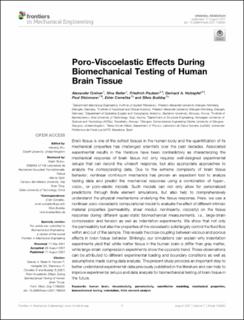| dc.contributor.author | Greiner, Alexander | |
| dc.contributor.author | Reiter, Nina | |
| dc.contributor.author | Paulsen, Friedrich | |
| dc.contributor.author | Holzapfel, Gerhard | |
| dc.contributor.author | Steinmann, Paul | |
| dc.contributor.author | Comellas, Ester | |
| dc.contributor.author | Budday, Silvia | |
| dc.date.accessioned | 2023-01-12T10:37:07Z | |
| dc.date.available | 2023-01-12T10:37:07Z | |
| dc.date.created | 2022-01-11T15:13:32Z | |
| dc.date.issued | 2021 | |
| dc.identifier.citation | Frontiers in Mechanical Engineering. 2021, 7 . | en_US |
| dc.identifier.issn | 2297-3079 | |
| dc.identifier.uri | https://hdl.handle.net/11250/3042972 | |
| dc.description.abstract | Brain tissue is one of the softest tissues in the human body and the quantification of its mechanical properties has challenged scientists over the past decades. Associated experimental results in the literature have been contradictory as characterizing the mechanical response of brain tissue not only requires well-designed experimental setups that can record the ultrasoft response, but also appropriate approaches to analyze the corresponding data. Due to the extreme complexity of brain tissue behavior, nonlinear continuum mechanics has proven an expedient tool to analyze testing data and predict the mechanical response using a combination of hyper-, visco-, or poro-elastic models. Such models can not only allow for personalized predictions through finite element simulations, but also help to comprehensively understand the physical mechanisms underlying the tissue response. Here, we use a nonlinear poro-viscoelastic computational model to evaluate the effect of different intrinsic material properties (permeability, shear moduli, nonlinearity, viscosity) on the tissue response during different quasi-static biomechanical measurements, i.e., large-strain compression and tension as well as indentation experiments. We show that not only the permeability but also the properties of the viscoelastic solid largely control the fluid flow within and out of the sample. This reveals the close coupling between viscous and porous effects in brain tissue behavior. Strikingly, our simulations can explain why indentation experiments yield that white matter tissue in the human brain is stiffer than gray matter, while large-strain compression experiments show the opposite trend. These observations can be attributed to different experimental loading and boundary conditions as well as assumptions made during data analysis. The present study provides an important step to better understand experimental data previously published in the literature and can help to improve experimental setups and data analysis for biomechanical testing of brain tissue in the future. | en_US |
| dc.language.iso | eng | en_US |
| dc.publisher | Frontiers Media | en_US |
| dc.rights | Navngivelse 4.0 Internasjonal | * |
| dc.rights.uri | http://creativecommons.org/licenses/by/4.0/deed.no | * |
| dc.title | Poro-Viscoelastic Effects During Biomechanical Testing of Human Brain Tissue | en_US |
| dc.title.alternative | Poro-Viscoelastic Effects During Biomechanical Testing of Human Brain Tissue | en_US |
| dc.type | Peer reviewed | en_US |
| dc.type | Journal article | en_US |
| dc.description.version | publishedVersion | en_US |
| dc.source.pagenumber | 18 | en_US |
| dc.source.volume | 7 | en_US |
| dc.source.journal | Frontiers in Mechanical Engineering | en_US |
| dc.identifier.doi | 10.3389/fmech.2021.708350 | |
| dc.identifier.cristin | 1978577 | |
| cristin.ispublished | true | |
| cristin.fulltext | original | |
| cristin.qualitycode | 1 | |

